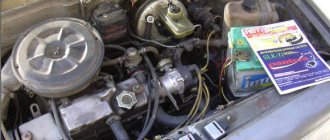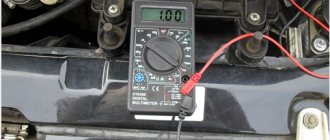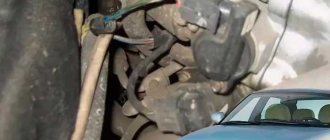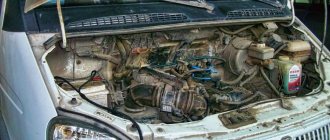Why does the Lada Granta fluctuate at idle and what to do
If the active use of the car continues for more than 3 years, the owner of the Lada Granta will not be able to avoid the problem of floating speed.
But in order to find out the true cause of what is happening on your own, you need to have at least basic knowledge about the design of your car. When starting the engine, you can observe the following picture: as it warms up, instead of a gradual decline, the speed decreases sharply, and then suddenly begins to change abruptly. In 60% of such cases, the reason is the occurrence of floating revolutions. In addition, the phenomenon often disappears immediately after the engine starts working. At the same time, visible manifestations disappear and everything returns to normal. But the situation will repeat itself in the future, and more than once.
Over time, the problem will get worse, so don’t put it off for too long. As a result, you will have to spend a lot on expensive repairs.
So why is this happening
Root causes of problems
The most common situations in which floating speeds occur:
- Cars with a built-in electronic fuel injection system suffer from such problems much more often than others. And this happens due to the constant suction of excess air, the volume of which still increases, which leads to the formation of a malfunction. The sensor responsible for gasoline injection simultaneously calculates the volume of air entering the cylinders. Based on these and some other indicators of the sensors, the electronic unit opens the electromagnetic injection valves for some time. It follows from this that when there is an excessive amount of air in them, the sensor, which is responsible for the position of the throttle valve, shows the driver that the task assigned to the system is impossible - the check light is on. During this, the temperature sensor indicates that the engine is exiting the warm-up mode. This indicates that it needs less fuel. Just at such a moment, floating speed appears in the car at idle, because the electronic unit does not understand what to do with the accumulated excess air in the system.
- This reason also partially relates to air suction and occurs mainly on 16-valve engines. The main place where air leaks still occur is the gluing contour of the receiver elements. Even minor damage to this area will lead to unstable operation of the motor.
- Constant jamming also easily becomes a reason for the occurrence of floating speed. It occurs in the crankcase ventilation valve. Therefore, if the reason is precisely this phenomenon, the systematic operation of the automatic power regulation sensor is disrupted. As a result, the same sensor signals instability of the engine. In a faulty state, the speed ranges from 1,300 to 900 per minute.
- In models with a carburetor engine, floating speed occurs due to a violation of the control of the servomotor. To correct this problem, simply unscrew the adjustment bolts in the area of the servomotor where the sensor points to the loose drive.
- Low pressure in the fuel system causes the same problems.
- Breakdowns in the ignition system are sometimes also classified as causes of floating speed. The problem is primarily related to high-voltage wires and spark plugs. But only with a visual inspection will it be possible to understand whether they are really the problem.
- A breakdown of the IAC (idle air regulator) causes floating speeds, because it is responsible for their initial stability. The element is inexpensive and can be replaced, so there may not be any significant problems with this.
- The electronic gas pedal has a lot of disadvantages, especially if tuning the car is only in the process, but the car is actively used. Floating speed is a fairly common occurrence in such a situation.
The speed can fluctuate not only when the engine is cold, but also when the engine is hot. It all depends on the cause of this phenomenon.
So what to do if floating speeds appear with enviable frequency and significantly interfere with the quiet use of the vehicle?
Causes of malfunctions
Reasons why repair or replacement of the TPS may be required:
- The contact elements have become acidic. This problem can hardly be called a breakdown, but it refers to malfunctions that can be eliminated. During prolonged use, the sensor contacts may oxidize. This is due to the operation of the TPS under conditions of temperature changes and exposure to moisture. To eliminate the problem, you need to dismantle the controller and clean the contact elements with cotton wool treated with WD-40.
- Erasing the coating based on the initial segment of the slider movement. If the resistive base is removed, the controller will not operate correctly. As the slider moves, the voltage supplied to the control module will increase. But as a result of erasing, this does not happen, since there is no resistance. This leads to problems, and sometimes the control module malfunctions.
- Damage to the tips on the device. If this happens, burrs will form on the lining, which will ultimately lead to failure of the remaining elements. In some cases, the contacts will continue to function, but this will not last long, especially since the wear on the substrate will increase. With such problems, the slider and the resistive layer will refuse to contact, which will lead to the inoperability of the machine’s motor.
- Slider failure. This component of the device wears out over long-term use. As a result, it may deviate from the required trajectory, which will lead to problems.
New Lada: Lada X Ray: description, technical characteristics, modifications
Floating engine speed
Engine speed problems can easily be identified by looking at the tachometer. Stable operation of the power unit at idle should not exceed 850 rpm. A small spread of 750 to 850 rpm is allowed. If the tachometer needle jumps chaotically—it goes down, then it goes up—there is a malfunction. This is a fairly common problem, and it is easy to identify why the speed of the Lada Granta is floating. It is enough to listen to the engine running - with unstable idle speed, the noise either decreases or increases.
The floating speed is also indicated by a characteristic vibration that will either subside or increase, transmitted through the engine compartment.
Why are the revs jumping?
The cause of the problem is the specifics of regulating the operation of the power unit at idle by the control unit. It continuously reads data about the status of various engine systems from sensors. If the idle speed becomes unstable, the sensors are given a command to correct the functioning of the system.
General information
Any car owner sooner or later faces a problem when the idle speed of the car fluctuates. If the car has been in use for several years, then you will inevitably have to face this problem. In order to determine the reason for this breakdown, you need to carefully understand the design of the car.
If, when starting the engine of a Lada Granta, it is observed that as it warms up, instead of smoothly decreasing, the speed simply disappears for a few seconds, and then operates spasmodically, then the reason is 60% precisely because the idle speed fluctuates .
However, the problems disappear after the engine continues to function. All visible symptoms suddenly disappear and the engine continues to operate normally. However, the problem will repeat itself every time it is started and will not go away.
With each subsequent use of the car, this problem will only get worse. Therefore, you should not postpone its solution indefinitely, as in the future this will lead to very expensive repairs.
Tips and tricks
Let's look at how you can eliminate some of the malfunctions that lead to floating and speed jumps, and do it yourself.
- As mentioned above, the leakage of excess air can cause surges. To exclude or confirm the possibility of supplying such air, you need to check the tightness of the air supply system to the intake. You can remove the air hose and feed it air from a compressor or pump by placing the hose in a container of water. This method helps to identify cracks.
- As for the idle air control, you need to measure the resistance with a multimeter. If the resistance is between 40 and 80 ohms, this means that the device is not working.
- Also, as part of diagnostic procedures, in some cases it is necessary to clean the crankcase ventilation valve. The valve must be removed and washed with carburetor cleaning fluid or kerosene. This approach will remove deposits from the valve.
- As for the ECM sensors, in this case it is not advisable to try to repair such elements. For example, if the mass air flow sensor is faulty, it is better to immediately replace it with a new one.
- It is better to trust specialists to flush the throttle valve without proper experience, especially if such flushing is necessary with the removal of the valve. If we talk about the method of flushing the throttle without removing it, you can do the procedure yourself. The hoses are disconnected from the valve, then a cleaning aerosol is injected into the throttle.
IAC diagnostics, idle speed sensor
Use a pxx tester to verify the presence of floating rpm
To check whether the speed on the Lada Granta is floating, look at the IAC sensor. It is located on the throttle body, therefore, in the same place as the sensor responsible for the throttle position. It is secured with two mounting screws. In order to verify its functionality, one multimeter will be enough.
To begin diagnostics, you need to turn off the ignition and disconnect the block to which the wire from the sensor leads, and, using a multimeter, measure the resistance level between the contacts of the regulator.
If the vehicle readings are normal, it should be within approximately 80 ohms. In the same case, if the indicators turned out to be significantly higher than the IAC norm, it will be necessary to replace it.
The idle speed sensor, abbreviated as IAC, is the same idle speed control, or IAC. Its immediate purpose is to stabilize and automatically adjust the idle speed of the Lada Grant, which is used in the daily functioning of the car. In appearance, it is an electric motor equipped with a cone-shaped needle.
At the moment when the ignition is turned on directly, the rod located on the regulator fully extends and rests against a specially made calibration hole. It is located directly in the throttle pipe. After this, the sensor begins to count steps until the required time and returns the valve to its original state upon completion of operation.
It is necessary to take into account that when you start warming up the Lada Granta engine, the sensor readings should not exceed 50 steps. If their volume is much smaller or larger, it means that air volumes are constantly changing, which in the future can lead to significant damage.
Specific engine faults
Old car models with a carburetor are still quite actively used by domestic car enthusiasts. Failure of various components of such power systems manifests itself in a noticeable drop in engine power and has the following characteristic malfunctions:
- Fuel pump failures causing a drop in pressure in the system.
- Dirt gets into the carburetor, which clogs the jets and causes problems with the operation of the needle valve.
- Incorrect adjustment of the composition of the combustible mixture.
- Malfunctions in the operation of the carburetor dampers and economizer valve.
- Incorrect float operation.
Some new engine models have one or more turbines that force air into the combustion chamber, thereby increasing the amount of horsepower that the power unit is capable of producing. Breakdowns or disruptions in their operation are caused by a sharp drop in the throttle response of the power unit.
A drop in engine power should be the reason for vehicle diagnostics to identify the malfunction and completely eliminate it. It’s good if the cause of loss of dynamics turns out to be such easily removable reasons as low-quality fuel, clogged filters or old spark plugs. But malfunctions in the operation of the gas distribution mechanism, wear of the piston group and other more serious problems require immediate repair, as they can lead to significant damage and significantly higher monetary costs.
Checking the idle air control
| If the engine runs rough at idle, then the cause may be a faulty idle speed control sensor. Before replacing it, you can check the IAC with your own hands. |
The IAC is an actuator and its self-diagnosis is not provided for in the system. Therefore, if the idle speed control malfunctions, the “CHECK ENGINE” lamp does not light up. Symptoms of IAC malfunctions are in many ways similar to TPS (throttle position sensor) malfunctions, but in the second case, most often the “CHECK ENGINE” lamp clearly indicates a TPS malfunction.
Testing IAC using a multimeter
Checking the IAC with a homemade tester
However, you can make a simple device for checking IAC yourself. You only need a 6V AC transformer from your mobile phone charger. Using the switches alternately, we check the forward and reverse strokes of the IAC rod. If the unit is working properly, the lamp (6V/0.6A) barely shines. A bright light indicates that the rod is jammed and needs to be cleaned and lubricated or replaced. Detailed diagrams and seals from the author. If the IAC turns out to be faulty, then choose a new one. Photo source: Key words:
Symptoms and triggers
At idle, the engine operates with light loads at a speed of 700-900 rpm, consuming minimal fuel. This well-regulated mode is necessary in various situations. It is ideal for warming up the engine, parking in traffic jams, and heating the interior in a parking lot.
Unstable operation of the engine at idle appears in the event of various malfunctions.
With constant pressure on the accelerator pedal, the rev surges are eliminated, so the engine runs smoothly while driving on the highway. In quieter driving modes the problems become more severe.
Unregulated idle speed
The idle air regulator may fail due to a violation of the integrity of the wires due to poor fuel.
This device controls blow-by gases that enrich the air-fuel mixture inside the intake manifold.
If this process is disrupted, then the engine speed drops from 1200 to 750 in 1 minute. In addition, the ventilation valve may jam due to the formation of oil deposits on the crankcase walls.
Dirty jets
The reason for the air-fuel mixture becoming too rich may be a nozzle clogged with dirt. This leads to a decrease in idle speed. In the case of a carburetor engine, it is necessary to adjust the fuel level and check the floats.
Piston and ring wear
In such situations, compression is lost, since the tightness of the cylinder block is often broken.
Wear of piston rings and gaskets leads to oil leaks, traces of which are visually visible on the base of the engine. This may cause interruptions when starting the car and disruption of engine stability.
Failure of the carburetor solenoid valve
If the engine stalls when coasting or idling, or pronounced detonation appears after the ignition is turned off, then these are clear signs of a malfunction of the EM carburetor. In addition, in such situations, instability of the running engine appears when an additional load is turned on.
Spent spark plugs
For stable engine operation, a stable spark is required, which ignites the mixture of air and fuel. These processes are ensured by the ignition system, which consists of spark plugs, an ignition coil, and high-voltage electrical wires. Glow plugs are used to ignite diesel fuel.
Depending on the design and material of the central electrode, spark plugs have different lifespans. As wear occurs and carbon deposits appear, a “wandering spark” effect may occur, which disrupts the stability of idle speed and makes it difficult to start the engine. Idle stability is affected by the condition of the spark plugs, wires, and ignition coil.
Look for air leaks in the intake manifold. Another problem is in the engine control system.
So it's more likely air past the throttle? I sat on Sunday for about 40 minutes in a warm car trying to catch a glitch with opendiag under Android - the speed never dropped. At the same time, at 8% purging of the adsorber, it already began to click, i.e. it seems to work adequately, otherwise people said that sometimes it starts to operate abruptly at only 30 percent, and is insensitive to a small percentage of opening, if it became old and the mixture at the moment of operation began to be too rich, on the other hand, then there would probably be detonation .. The parameter “adapted deviation of air flow in the intake manifold past the throttle (kg)” showed from zero to 0.21
In traffic today we got stuck a couple of times in 20 minutes. In this case, once while the radiator fan is operating, the coolant is at 95 degrees. And the second time at 80 degrees on the coolant, the fan did not work.
Could it be that some channel shakes while driving, and air begins to be sucked past the throttle? It's just strange that this happens rarely and intermittently, and not constantly.
I don’t have a TPS, I have an electronic pedal, and I recently changed the throttle assembly, I also thought there was a problem with it.
Lada Granta float revs
- Registration
- Entrance
- To the beginning of the forum
- Forum Rules
- Old design
- FAQ
- Search
- Users
The blown fuse was replaced in the summer. it was 50 A. I don’t know what my brain is like. Will there be markings on the ECU? I just have it sealed in a case so it doesn’t flood. About the rpm waves - they start jumping 500-800, then the amplitude increases by 300-1000, you have to apply more gas, otherwise the car shakes and the interval between waves is 10-15 seconds. Sometimes the revs stop jumping for a couple of minutes, then start again. Regarding the TPS, I'll measure it. When diagnosing, I think nekor. The sensors should have worked. There are many reasons too. That’s why I’m asking because driving in a traffic jam is not possible. And at the service they shrug their shoulders. Everything is working fine for you, wait for a malfunction to appear, but it does not appear for 2 years. Money is tight so it's hard to keep changing everything. And regarding the firmware, can it be identified or flashed and see what happens?
Added after 1 minute 33 seconds:
If memory serves, at the first MOT they said that the head was Boch. Yes exactly, Bosh.
I found this on the Internet: “Usually this effect occurs in engines with electronic fuel injection and is associated, as already mentioned, with abnormal air leaks. The fact is that injection engines have a control unit, or as it is also called, a computer. This computer calculates the amount of air entering the cylinders and, taking into account the state of a number of sensors, opens the solenoid valves of the injectors (or one injector, if the system is Ci) at one time or another. And so, when “extra” air comes in, and the throttle position sensor “says” that there shouldn’t be any, the temperature sensor says that the engine has already left the warm-up mode and less fuel needs to be poured, as a result, “that computer” has a “roof” is traveling,” he doesn’t know what to do with this “extra” air. This whole situation leads to the fact that the engine speed periodically begins to change: then 800 rpm, then 1200 rpm, and so on with a period of about 3 seconds. We can also say that in this case the automatic regulation of the power system is disrupted. We act in this situation simply. First we try to tighten the speed adjustment screw.
With this we block the hole through which air enters for operation in unstable mode. Then it may coincide that the “extra” air will ensure operation in this mode. If this operation does not give the desired result, then using pliers we squeeze all the rubber tubes one by one. If, when a tube is pinched, the engine speed levels out and becomes stable, then you need to disconnect this tube (remove it from the pipe) and determine, by plugging the hole with your fingers, where, on which side, the “excess” air is coming from. After that, we “approach” some device through the tube. Here you will need to figure out what kind of device this is and why it allows air to pass through. Most likely it will be a starting device, a device for maintaining speed, or some kind of valve, most often a crankcase ventilation valve. The first two devices are made so that, in certain cases, air flows into the intake manifold through them, bypassing the throttle valve. Based on the amount of this air, the control unit must add fuel if this amount is consistent with the readings of other sensors. But if, for example, the engine has already overheated, and the bellows in the warming device has not closed its valve, and air continues to flow through it into the manifold, bypassing the throttle valve, then this air becomes “extra.” On some engines (Toyota 1G), the heating device is made integral with the throttle body (on engine 10 it is located below, under the throttle body) and then there are no rubber tubes. If at “floating speed” you have pressed all the rubber tubes in turn, but there is no result, you can safely remove the air duct in front of the throttle valve block. In the pipe, in front of the throttle valve, you will see a hole with a diameter of about 1 cm, through which air flows bypassing the throttle valve. Start the engine and plug this hole with your finger. There is one point here. Engines with injection necessarily contain a device for measuring the amount of intake air. This could be a flow meter on the intake pipe after the air filter (mechanical for Toyota, etc., and thermal for Nissan, etc.) or a vacuum sensor after the throttle valve. If there are any “things” on the intake air duct after the air filter that have more than three wires going to them, then you have an air sensor or flow meter, and by removing the pipeline that supplies air to the throttle valve, you will turn off this sensor from operation of the entire injection system, which can make (and most likely will make) engine operation impossible. If the engine speed immediately becomes normal, then you can try to spray some kind of carburetor cleaning aerosol into this hole and immediately turn off the engine. Then pour the cleaner into the hole again and, after letting the engine sit for 15 minutes, start it. Sometimes this helps, and the valve of the warming device begins to work normally again. If nothing changes, then you need to either plug the hole (for example, with a wooden “chop”) and then the engine will not have warm-up speeds, or buy a new throttle body. Although it is probably possible to try to repair a stuck bellows rod. The second “thing” on an injection engine that can allow abnormal air to pass through is a forced idle speed increase device. It is installed on top of the Toyota 1G-GEU engine and immediately catches your eye: a kind of motor to which three or more wires fit. On some engines, only two wires may fit. You can always “figure out” this device if you follow the tube, pinching which normalizes engine operation. At the moment of starting, this device opens the valve, and after the engine starts, it closes. It is used to force an increase in speed, for example, when turning on the air conditioner, when starting the engine, or when the load on the engine increases. When the valve “does not hold,” and this is easy to find out by squeezing the tube that fits it, you can try to disassemble it and clean it, maybe install a gasket, replace the torus. But on many engines these devices may not be dismountable, then there is only one way out - to change them. The third reason for the “floating” speed, which was found on engines with injection, is the sticking of the crankcase ventilation valve. Without further ado, you can remove the ventilation tube and plug it, and simply put a rubber tube on the pipe located on the valve cover and lower it down. Russian trucks drive with this kind of ventilation. But if you wish, you can try to clean this valve: soak it in a solvent and blow it with air. Sometimes it helps. In carburetor engines, the reason for the “floating” engine speed may be incorrect adjustment of some servomotor, which slightly opens the throttle valve in certain cases. Unscrew the adjusting screws of the servomotor, the drive of which jerks in time with the “swimming” of revolutions, and everything will immediately calm down. This breakdown occurred only in those engines where they tried to regulate something, for example, many “craftsmen”, in order to find the idle speed adjustment screw on the carburetor (throttle valve thrust screw), turn all the screws little by little in a row. For God's sake. But if the engine does not react to them in any way, they must be returned to their original state. And then it turns out that in some operating mode “gaps” appear in the gas, the speed “floats”, high fuel consumption, and so on. In diesel engines, this defect (“speed floats”) can appear not only at idle, but also at 1000 rpm and at 1500 rpm. There has been only one reason for this so far - the moving blades in the feed pump are stuck. Seizing occurs only due to rust, and this is due to water in the fuel. This usually happens with cars that have been standing for a long time. In fact, there are recommendations for the case when you are going to park your car with a diesel engine for a long time. Let's say you need to go on a business trip for a month. On the eve of departure, fill the fuel tank with about a liter of motor oil and drive on this fuel for the last day. The engine will smoke, but all the parts in the fuel injection pump will be covered with a thin oil film.” This article might help
Route map for eliminating unstable XX on a VAZ 2170
Unstable idle is caused by the fact that the computer incorrectly perceives or does not know at all the amount of air sucked into the intake manifold. A typical treatment recipe looks like this:
- Check the sensors (IAC, DFID, TPS) and replace the faulty ones.
- Make sure that the adsorber valve is in good condition.
- If, after cleaning the throttle valve on the VAZ 21126 engine, the speed fluctuates, you need to make sure that there is no air leakage through the connections to the pipes.
- Check whether the diaphragm in the vacuum brake booster is intact.











